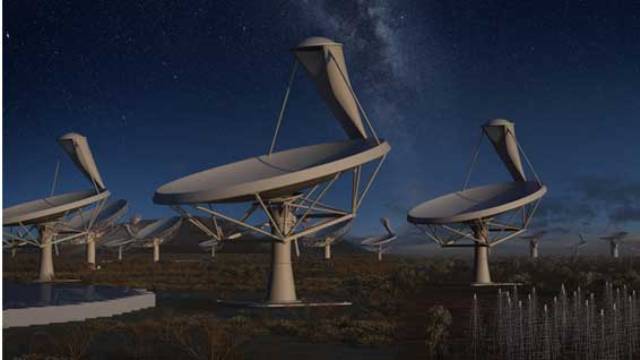Nov 25 2014
A team of astrophysicists, engineers and computer scientists are spearheading research on imaging techniques which will potentially not only unlock secrets from the far reaches of the universe, but also impact modern medicine.
A new generation of imaging techniques
 Artist's impression of the Square Kilometre Array at night. Image: SKA Organisation.
Artist's impression of the Square Kilometre Array at night. Image: SKA Organisation.
Some of the most exciting challenges in astronomy for the next decade range from searching for extraterrestrial forms of life to questioning Einstein’s theory of gravitation, and trying to unveil the mysteries of the dawn of the universe.
Radio interferometric telescope arrays are unique instruments in that aim, recording and correlating electromagnetic waves to provide high-resolution images of the sky. The data holds partial information only and does not provide immediately recognisable visual images. Complex mathematical algorithms are required to recover the images of the sky under scrutiny.
Dr Yves Wiaux at Heriot-Watt University’s Institute of Sensors, Signals, and Systems (ISSS) and Dr Jason McEwen at University College London’s (UCL) Mullard Space Science Laboratory (MSSL), along with colleagues have been awarded £2 million over three years from UK research councils, to answer these challenges by developing a new generation of imaging techniques.
Future radio telescopes such as the flagship Square Kilometer Array (SKA), planned for 2023, are expected to image the sky with much higher resolution and sensitivity than current instruments. SKA antennas will extend over two continents (Africa and Australia) and record unprecedented volumes of data. This monster telescope will collect so much data in a single day that it would take nearly two million years to playback on an iPod.
Dr Yves Wiaux said, “Radio astronomical imaging urgently needs to be re-invented in this ultra-precision and Big Data context, where the recent theory of compressive sampling has huge potential.”
This mathematical theory of compressive sampling proves that complex natural images can actually be recovered from partial information. It provides both new concepts to optimise the data acquisition procedure and leverages powerful mathematical algorithms to recover the image of interest from the partial information.
The project
The project will investigate ways to redesign telescope array configurations, so that each data point contains the maximum amount of information, while novel recovery algorithms will also be designed and applied to reconstruct ultra-high resolution images of the sky.
Dr McEwen said, “Next-generation radio telescopes like the SKA pose a tremendous Big Data challenge, where novel computing methodologies and algorithms will be absolutely essential."
State-of-the-art computing techniques and architectures will ensure the algorithms developed will run on the world’s largest super-computers and will scale to the Big Data regime of the SKA. Well-engineered software embodying these algorithms will be a critical research output and will be made openly available to the radio astronomy community.
The new imaging techniques will also find direct application in many other fields of science and technology. They will impact biomedical imaging, in particular magnetic resonance imaging (MRI), by providing faster scans, and the team will transfer their techniques from astronomical imaging to neuroimaging.
High angular resolution diffusion MRI probes the direction of water diffusion at each point in the brain with the aim of reconstructing global neuronal pathways. This is fundamental for neuroscience and currently attracts huge interest in the scientific community.
On the clinical side, it would also provide new diagnostic methodologies for neurological disorders such as Alzheimer’s disease, with subsequent benefits for healthcare in terms of diagnosis quality and costs. Typical scan times, however, are far too long for clinical application at present, due to the exceptionally large data volumes of interest.
Dr Wiaux said, “The project will again use the theory of compressive sampling to accelerate diffusion MRI scans significantly, opening the door to the clinical application of high angular resolution diffusion MRI."
Dr McEwen said, “Exactly the same recovery algorithms as those to be developed for radio astronomy will be used for neuroimaging: instead of imaging the stars and galaxies in the Universe, we will reconstruct structural neuronal connectivity in the brain.”
The project awarded comes in the context of a larger initiative of the investigators for ‘compressive imaging in astronomy and medicine’. The team has worldwide recognized expertise in the field.
Source: http://www.hw.ac.uk/